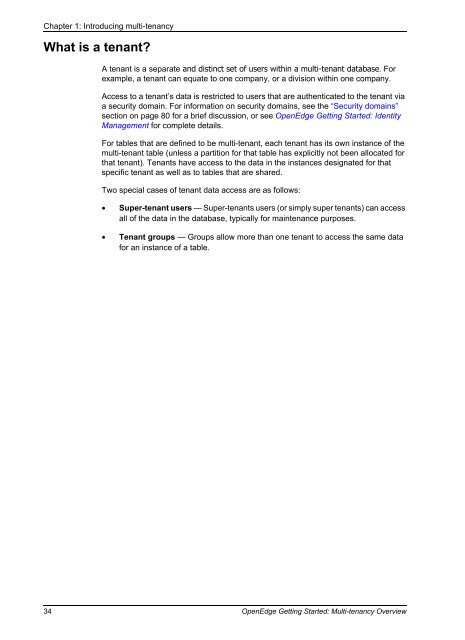OpenEdge Getting Started: Multi-tenancy Overview - Product ...
OpenEdge Getting Started: Multi-tenancy Overview - Product ...
OpenEdge Getting Started: Multi-tenancy Overview - Product ...
Create successful ePaper yourself
Turn your PDF publications into a flip-book with our unique Google optimized e-Paper software.
Chapter 1: Introducing multi-<strong>tenancy</strong><br />
What is a tenant?<br />
A tenant is a separate and distinct set of users within a multi-tenant database. For<br />
example, a tenant can equate to one company, or a division within one company.<br />
Access to a tenant’s data is restricted to users that are authenticated to the tenant via<br />
a security domain. For information on security domains, see the “Security domains”<br />
section on page 80 for a brief discussion, or see <strong>OpenEdge</strong> <strong>Getting</strong> <strong>Started</strong>: Identity<br />
Management for complete details.<br />
For tables that are defined to be multi-tenant, each tenant has its own instance of the<br />
multi-tenant table (unless a partition for that table has explicitly not been allocated for<br />
that tenant). Tenants have access to the data in the instances designated for that<br />
specific tenant as well as to tables that are shared.<br />
Two special cases of tenant data access are as follows:<br />
• Super-tenant users — Super-tenants users (or simply super tenants) can access<br />
all of the data in the database, typically for maintenance purposes.<br />
• Tenant groups — Groups allow more than one tenant to access the same data<br />
for an instance of a table.<br />
34 <strong>OpenEdge</strong> <strong>Getting</strong> <strong>Started</strong>: <strong>Multi</strong>-<strong>tenancy</strong> <strong>Overview</strong>
















